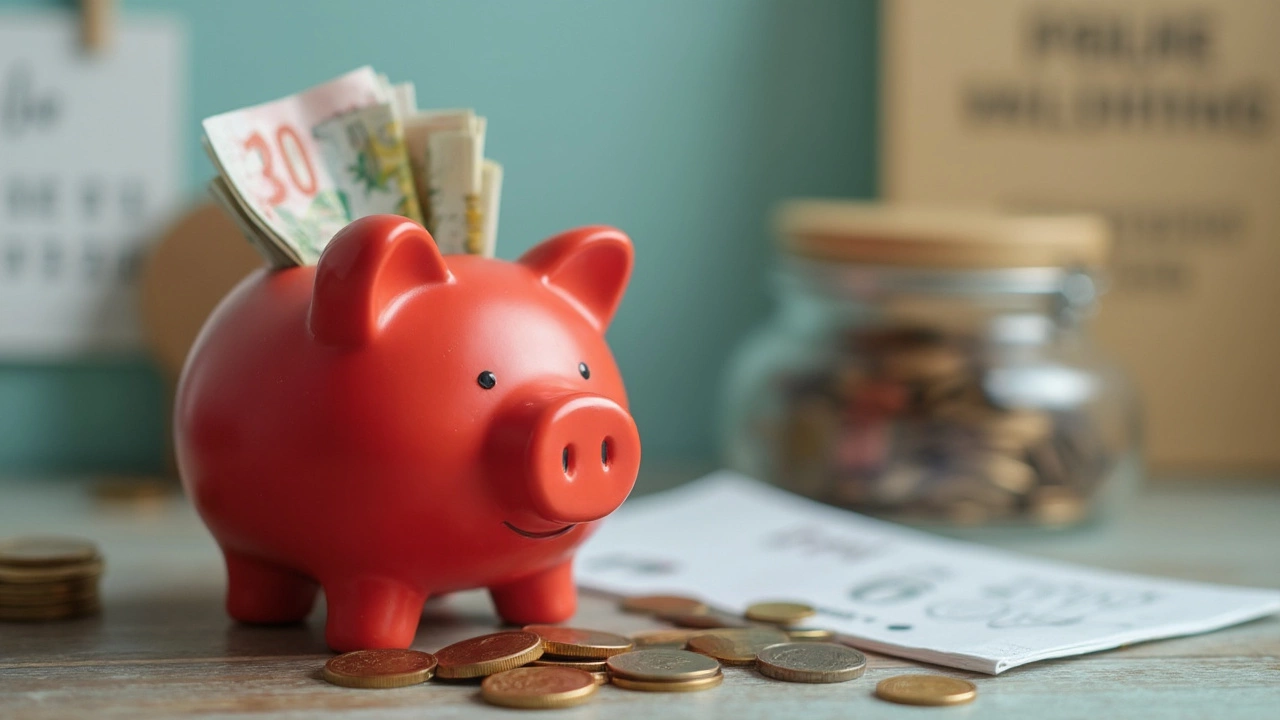What Is a Good Amount in Savings? Real Numbers That Make Sense
 Apr, 25 2025
Apr, 25 2025
Savings accounts aren’t just for people who love spreadsheets. If you’ve felt anxious seeing your balance barely cover next week’s bills, you already get why having a cushion matters. A good savings account is like a stress-relief tool—if life surprises you with a flat tire or a lost job, you won’t be thrown into panic mode.
So how much should you actually have tucked away? You’ll hear a lot of advice—some experts toss out three months’ expenses, while others go bigger with six or even twelve. The truth is, where you live and how you live matter. Rent in Austin isn’t the same as in rural Kentucky. What counts is having enough to keep your head above water if your income suddenly stops or you get hit with something that insurance can’t cover.
- Why Savings Matter More Than Ever
- How Much Should You Really Have Saved?
- Building a Savings Plan That Works for You
- Common Pitfalls and Smart Workarounds
Why Savings Matter More Than Ever
You’ve probably noticed stuff seems less predictable these days. Layoffs hit in tech, hospital bills show up out of nowhere, and things like groceries and rent just keep getting more expensive. That’s exactly why a solid savings account can make or break your peace of mind.
Did you know over half of Americans can’t cover a $1,000 emergency from savings? That’s not a random stat—it came from a Bankrate survey in early 2024. Basically, too many people are a broken appliance or flat tire away from a real headache. Whether it’s job loss, medical stuff, or just your car being stubborn, having a savings goal means you’re not reaching for your credit card every time life happens.
Here’s why stashing money is worth it right now:
- Unexpected Expenses: Even a minor emergency can set you back hundreds. Fixing a leaky roof or replacing tires never comes at a good time.
- Job Instability: Layoff rates in some industries are the highest they’ve been since 2020. If work dries up, you’ll still need to cover bills.
- Rising Costs: Inflation means your dollars don’t go as far as they used to. Saving a bit more now covers next month’s price hikes.
- Opportunities: Sometimes savings aren’t just about surviving. Got a chance to move for a better job or snag a discounted laptop? Your savings can make that a reality.
Think of a savings account as your first defense against chaos. It’s not just about fear—it’s about giving yourself more choices and less money stress no matter what’s going on in the world.
How Much Should You Really Have Saved?
This is the million-dollar question—except most people aren’t aiming for a million. For most folks, hitting a target that just feels doable is what matters. The classic rule from financial planners is to keep at least three to six months’ worth of living expenses in your savings account. That means things like rent, food, utilities, car payments, and insurance.
Here’s the thing: these numbers aren’t just pulled out of thin air. According to a 2024 NerdWallet report, the average American household spends around $5,500 a month on basic needs. So, a solid emergency fund for the average person might be $16,500 to $33,000. That sounds huge—but remember, you don’t have to save it all at once.
| Monthly Expenses | 3-Month Savings Goal | 6-Month Savings Goal |
|---|---|---|
| $2,000 | $6,000 | $12,000 |
| $3,000 | $9,000 | $18,000 |
| $5,500 | $16,500 | $33,000 |
A beginner’s milestone? Aim for $1,000 in your savings account as a starter emergency fund. That covers a busted water heater, a car repair, or a last-minute plane ticket for family emergencies. After that, work your way up month by month.
- If your job feels pretty stable and you don’t have kids, three months of expenses might be enough.
- If you’re freelancing, own your own business, or have a family, six months (or even more) is smarter.
And don’t forget—these goals aren’t just for rainy days. They set you up to actually feel good about your money. The point is to tailor your savings goal to what keeps you sleeping at night, not some number that stresses you out.

Building a Savings Plan That Works for You
Setting up a savings account is one thing—building up the balance is another. It’s not about giant leaps; it’s about sticking to small, smart moves month by month. The first step? Figure out exactly what you want from your savings. Is it money for emergencies, a big purchase down the road, or just peace of mind? Your goal will shape how you save.
Experts recommend aiming for at least three to six months of living expenses in your savings account for emergencies. That means you need a clear picture of what you spend on basics like rent, groceries, insurance, and bills. Grab your last three months’ bank statements and do a quick average.
If that number feels overwhelming, break it down. For example, if your baseline expenses are $2,000 per month and you want to hit three months, that’s $6,000 total. Saving that in a year means about $500 per month.
| Savings Goal | Monthly Target | Timeline |
|---|---|---|
| $3,000 | $250 | 1 year |
| $6,000 | $500 | 1 year |
| $6,000 | $250 | 2 years |
Automate your savings. Most banks let you set recurring transfers from checking to savings, and there are apps that round up your purchases and stash the difference. The less you have to remember, the easier it is to stick with it.
Even if your budget is tight, look for small wins—cut a $5 subscription or pack lunch twice a week. Put that extra cash straight into your savings account. The biggest thing is consistency; it matters more than the exact dollar amount you add each month.
If you want your money to grow a bit faster, check out high-yield savings accounts. Some online banks were offering rates well above 4% APY in early 2025, which easily beats the pennies you used to get from traditional banks.
Set reminders every few months to check your progress and see if your target needs adjusting. If you get a raise, bump up your monthly transfer—even $25 more makes a difference. Treat saving like a bill you always pay, not something you do with leftover cash.
Common Pitfalls and Smart Workarounds
Here’s the thing: saving money sounds simple, but there are a few traps almost everyone stumbles into. Even folks with steady paychecks can see their savings account stuck at the same number month after month. Let’s break down where things usually go wrong—and how to get around it.
One of the top mistakes is aiming way too high, way too fast. You read an article saying you need $10,000 in your emergency fund and suddenly feel like you’re failing if you don’t have it tomorrow. This usually leads to frustration and giving up. Instead, think about building up small milestones, like your first $500, then $1,000. Small wins keep you motivated and growing.
Another big trap: using your savings account as a checking account. The idea is to keep your savings off-limits for anything but true emergencies. If you keep moving money back and forth, it’s almost impossible to keep track or build anything up. A lot of people fix this by setting up a separate account at a different bank—just enough out of reach that you won’t be tempted to dip into it for take-out or a new gadget.
Here’s a quick look at some classic savings pitfalls, along with smart fixes:
- Not automating savings: Relying on willpower rarely works. Automate a transfer right on payday, even if it’s just $25. Most banks let you set this up in minutes.
- Ignoring small windfalls: Got a tax refund or birthday money? Toss a portion straight into your savings account instead of spending it all.
- Living paycheck to paycheck: Easier said than done, especially after inflation hit grocery prices hard. Try tracking all spending for a couple weeks—you’ll spot leaks you can patch.
- Underestimating expenses: People often forget about annual costs like car insurance or holidays. Build mini-savings buckets for these, so they don’t wreck your main fund.
According to a 2023 Federal Reserve study, about 37% of Americans can’t cover a $400 emergency from their savings account. That means if you even have a few hundred set aside, you’re already ahead of the curve. But don’t stop there—keep working those small, steady habits. Set phone reminders if you have to, or use an app that lets you squirrel away change on every purchase. Little tweaks add up faster than you’d think.
